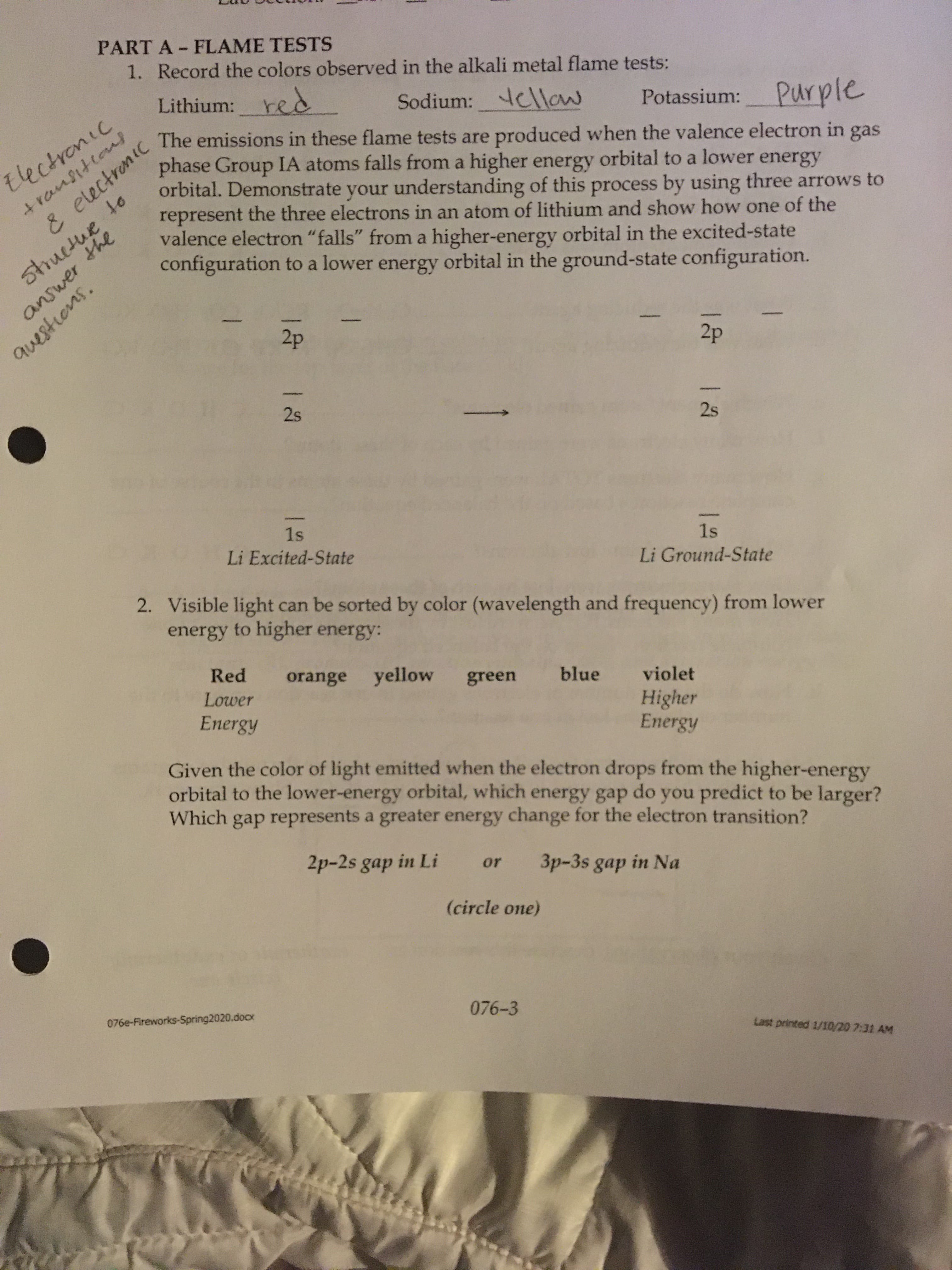PART A - FLAME TESTS 1. Record the colors observed in the alkali metal flame tests: Lithium:red Sodium:Nclow The emissions in these flame tests are produced when the valence electron in gas phase Group IA atoms falls from a higher energy orbital to a lower energy orbital. Demonstrate your understanding of this process by using three arrows to represent the three electrons in an atom of lithium and show how one of the valence electron "falls" from a higher-energy orbital in the excited-state configuration to a lower energy orbital in the ground-state configuration. Potassium: Purple transitions & electronic Electronic structue to answer the auestions. 2p 2p 2s 2s 1s Li Excited-State 1s Li Ground-State 2. Visible light can be sorted by color (wavelength and frequency) from lower energy to higher energy: Red orange yellow Lower green blue violet Energy Higher Energy Given the color of light emitted when the electron drops from the higher-energy orbital to the lower-energy orbital, which energy gap do you predict to be larger? Which gap represents a greater energy change for the electron transition? 2p-2s gap in Li or 3p-3s gap in Na (circle one) 076e-Fireworks-Spring2020.docx 076-3 Last printed 1/10/20 7:31 AM
PART A - FLAME TESTS 1. Record the colors observed in the alkali metal flame tests: Lithium:red Sodium:Nclow The emissions in these flame tests are produced when the valence electron in gas phase Group IA atoms falls from a higher energy orbital to a lower energy orbital. Demonstrate your understanding of this process by using three arrows to represent the three electrons in an atom of lithium and show how one of the valence electron "falls" from a higher-energy orbital in the excited-state configuration to a lower energy orbital in the ground-state configuration. Potassium: Purple transitions & electronic Electronic structue to answer the auestions. 2p 2p 2s 2s 1s Li Excited-State 1s Li Ground-State 2. Visible light can be sorted by color (wavelength and frequency) from lower energy to higher energy: Red orange yellow Lower green blue violet Energy Higher Energy Given the color of light emitted when the electron drops from the higher-energy orbital to the lower-energy orbital, which energy gap do you predict to be larger? Which gap represents a greater energy change for the electron transition? 2p-2s gap in Li or 3p-3s gap in Na (circle one) 076e-Fireworks-Spring2020.docx 076-3 Last printed 1/10/20 7:31 AM
Principles of Modern Chemistry
8th Edition
ISBN:9781305079113
Author:David W. Oxtoby, H. Pat Gillis, Laurie J. Butler
Publisher:David W. Oxtoby, H. Pat Gillis, Laurie J. Butler
Chapter5: Quantum Mechanics And Atomic Structure
Section: Chapter Questions
Problem 58AP: (a) Give the complete electron configuration (1s22s22p) of aluminum in the ground state. (b) The...
Related questions
Question
Please answer #1 and #2

Transcribed Image Text:PART A - FLAME TESTS
1. Record the colors observed in the alkali metal flame tests:
Lithium:red
Sodium:Nclow
The emissions in these flame tests are produced when the valence electron in gas
phase Group IA atoms falls from a higher energy orbital to a lower energy
orbital. Demonstrate your understanding of this process by using three arrows to
represent the three electrons in an atom of lithium and show how one of the
valence electron "falls" from a higher-energy orbital in the excited-state
configuration to a lower energy orbital in the ground-state configuration.
Potassium: Purple
transitions
& electronic
Electronic
structue to
answer the
auestions.
2p
2p
2s
2s
1s
Li Excited-State
1s
Li Ground-State
2. Visible light can be sorted by color (wavelength and frequency) from lower
energy to higher energy:
Red
orange yellow
Lower
green
blue
violet
Energy
Higher
Energy
Given the color of light emitted when the electron drops from the higher-energy
orbital to the lower-energy orbital, which energy gap do you predict to be larger?
Which gap represents a greater energy change for the electron transition?
2p-2s gap in Li or
3p-3s gap in Na
(circle one)
076e-Fireworks-Spring2020.docx
076-3
Last printed 1/10/20 7:31 AM
Expert Solution
This question has been solved!
Explore an expertly crafted, step-by-step solution for a thorough understanding of key concepts.
This is a popular solution!
Trending now
This is a popular solution!
Step by step
Solved in 2 steps with 2 images

Knowledge Booster
Learn more about
Need a deep-dive on the concept behind this application? Look no further. Learn more about this topic, chemistry and related others by exploring similar questions and additional content below.Recommended textbooks for you

Principles of Modern Chemistry
Chemistry
ISBN:
9781305079113
Author:
David W. Oxtoby, H. Pat Gillis, Laurie J. Butler
Publisher:
Cengage Learning

Chemistry: An Atoms First Approach
Chemistry
ISBN:
9781305079243
Author:
Steven S. Zumdahl, Susan A. Zumdahl
Publisher:
Cengage Learning

Chemistry
Chemistry
ISBN:
9781305957404
Author:
Steven S. Zumdahl, Susan A. Zumdahl, Donald J. DeCoste
Publisher:
Cengage Learning

Principles of Modern Chemistry
Chemistry
ISBN:
9781305079113
Author:
David W. Oxtoby, H. Pat Gillis, Laurie J. Butler
Publisher:
Cengage Learning

Chemistry: An Atoms First Approach
Chemistry
ISBN:
9781305079243
Author:
Steven S. Zumdahl, Susan A. Zumdahl
Publisher:
Cengage Learning

Chemistry
Chemistry
ISBN:
9781305957404
Author:
Steven S. Zumdahl, Susan A. Zumdahl, Donald J. DeCoste
Publisher:
Cengage Learning


Introductory Chemistry: A Foundation
Chemistry
ISBN:
9781337399425
Author:
Steven S. Zumdahl, Donald J. DeCoste
Publisher:
Cengage Learning

Chemistry: The Molecular Science
Chemistry
ISBN:
9781285199047
Author:
John W. Moore, Conrad L. Stanitski
Publisher:
Cengage Learning